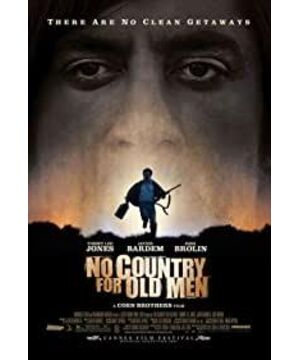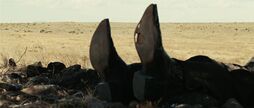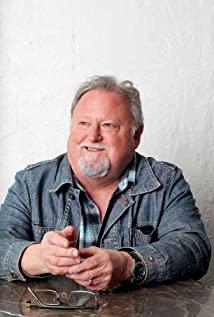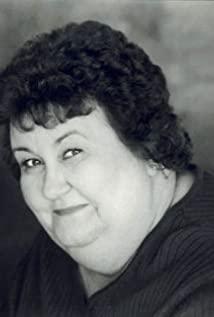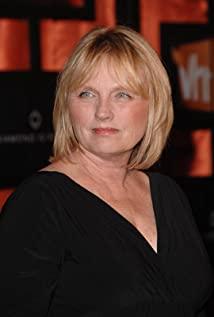1. The title of the film is "NO COUNTRY 4 OLD MEN" ". Literally, the old man should refer to the sheriff, but the plural is used here, that is to say, not the sheriff alone. At the same time, from the perspective of the whole film, whether it represents the killer of the god of death or the mortal of selfish desire moss, they have nowhere to hide.
2. The name of the killer is ANTON CHIGURH, which seems to be a design with ulterior motives (moss twice referred to as sugar in the hospital). ROGER EBERT also specifically mentioned this name in the film review, but he didn't know why.
3. Regarding the plot of moss sending water to the dying Mexican, it is a very critical plot. Although $200M was the source of moss's death on the road, the act of sending water also caused moss to embark on the road of death prematurely. Everyone basically thinks that moss is out of good intentions, but I think it is not the case: first, when moss saw the Mexican who was shot in the abdomen during the day, he did not show the slightest kindness, but closed the car door indifferently; secondly, When moss found this person, it should be close to noon (moss looked at the watch and the time was less than 12 o'clock), and he delivered water in the early morning of the next day. Obviously, after such a long time, even if the person had not suffered from blood loss. Too many to die, and it is impossible to save him by sending some water (although it can be seen from the broken window and shot in the head that he was later killed by other Mexicans). Therefore, the kindness here is untenable. So why exactly? Of course there is no reason. The film is always narrated in an impermanent way, so moss sending water is also an unreasonable behavior, so there is no need to put a good hat on moss.
4. In the first part of the film, the "dog" was highlighted 4 times: when moss was hunting, he saw a dog that seemed to be injured (to be verified); when moss found a vehicle and a corpse, there was a close-up of a dead dog; moss Sending water was hunted down and shot and killed a dog chasing him; when the sheriff went to see the scene of the corpse, the police officer who followed him said, "They even killed dogs." From these few scenes, we have seen: from the moss watching the dog limp and leaving, to the dog jumping on the moss and being shot, to the police officer saying "They kill even dogs", this series of "dogs" The arrangement seems to illustrate the relationship between a killer and a moss in front of a dog.
5. The killer's weapon is an air gun used to kill animals. Using it to kill people fully demonstrates that the killer is the incarnation of death. The clergy put the cross on the forehead of the believer, and the killer put the weapon on the forehead of others. Of course, this explanation is a bit far-fetched, and at the same time, the use of this weapon is also contradictory when it comes to the way the killer kills. Because, from the beginning of the killer killing police officer staring at the ceiling and the killer pulling the curtain before killing a Mexican, the killer is so cruel and indifferent to not look at the face of the killed (this is very different from the clown in The Dark Knight, haha), But when using an air gun, the killer has to watch the victim put the air pump on his forehead. This point needs to be discussed.
6. Among the people who were killed by the killer in the film, it was unreasonable for the two people who started hiring him to be killed. I think everyone thinks it was because of those two people who spoke badly, but I think it is not the case. The two people only yelled "bitch", and at the end the two kids also yelled "fucking", but they were not killed, so it was not the reason that the words were rude. The real reason was that after the killer confirmed the person who took the money and got the receiver, he thought that the two people were worthless, and it was even a trouble for him to find $200M, so he killed them. This can also be confirmed in the subsequent dialogue between moss and wells: Anton will kill anyone who causes him inconvenience without hesitation.
7. On the other hand, there are no people killed by the killer in the film. The grocery store owner chose the right coin and the killer followed the principle; as for the manager, everyone thought that because she was a lady, killing her would violate the killer principle. . However, the film does not say that the killer's principle includes not killing the lady, and the killer also killed the wife of moss. At the same time, this aunt did bring inconvenience to the killer. Therefore, the reason why she didn't kill her was because the killer heard the flushing sound of the toilet, which proved that there were other people there, and he didn't want to have extra branches because of this unnecessary killing.
8. There is an ingenious aspect in the film. The killer and the sheriff are arranged to sit in the same place drinking milk, and staring at the TV screen to see their respective shadows. The sheriff said: He (the killer) and I saw the same thing. What is this thing? What the killer saw was himself, and what the sheriff saw was the boy who killed his little girlfriend in the opening narrative, who is now the killer.
9. In the movie, the killer uses coins to show that he is principled, which is similar to the transformed prosecutor's approach in The Dark Knight. It is the same coin that determines life and death, but I feel that the prosecutor’s coin is more profound.
10. Everyone thinks that the killer is a perverted murderer, but judging by the more details in the film, it seems that the Coen brothers deliberately portrayed him as a near-perfect incarnation. The series of killings from the police officer to the three Mexicans embodied his murder. His ability is strong. Frequent changes in cars, removal of car logos, and phone calls to find moss reflect his wit. Tracking receivers and a series of actions reflect his planning. The lightness of his hands expresses his caution, from the bottom up. Opening the drawer to find money reflects his orderliness. Killing the cashier and returning to the hotel to kill the wells reflects his bravery. During the conversation with the wells, he was not alarmed by the phone ring that suddenly remembered (wells was taken aback). Thanks to his sedation, even when he went to the pharmacy to get medicine to heal his wounds and avoid blood stains, he appeared to be a perfect killer.
11. There is a lot of controversy about the sudden and hasty death of moss. In fact, at the beginning of the film, when Moss talked with his wife, he already explained his fate: Moss asked his wife to tell his mother that Moss loves her, and Moss said that his mother was already dead. Moss said, let me tell her. . The meaning here is that moss must die. As for why the moss was arranged to be killed by the Mexicans, I think it was firstly because it matched the film's theme of impermanence, and it was also a trick by the Coen brothers to tease the audience deliberately. Therefore, it would be superfluous to introduce the death of moss in detail.
12. The biggest question: Who on earth took that $200M? There is no doubt that it is a killer (you can see the screws removed from the room and the coins used by the killer). At the same time, the main line of $200M runs through the entire film, and the always omnipotent and perfect killer will suffer the same fate as moss after he gets the money. He will have a car accident after the green light, and there is nowhere to hide. Greed makes him no different from a mortal, even if he is the incarnation of death. This is also a great irony.
13. Many plots of the film are vague. For example, how wells find moss in three hours, you still don't understand no matter how you analyze it. This arrangement by the director shows that the director does not know the reason. This is just a fact. So Cohen arranged this adjustment in the role of the sheriff, and he no longer understood the people and things around him. Cohen used his and the killer's coins to tell the audience that there is no reason for the impermanence of life, just like this movie.
"Old Nowhere" is undoubtedly one of the best works of the Coen Brothers (including "Ice Blood Storm"), but I found that this may be the only film by the Coen Brothers that is not dedicated to storytelling, and it has no ending at all. However, it won an Oscar. What does this show?
Although this is a great movie, I think it has been overrated. Even though it has almost perfect plot character settings, performances, and lens use, it can be seen from repeated interpretations that the biggest flaw of "Old Nowhere" is that it pays too much attention to details, so that it is too distracting. Because too many carefully arranged details may turn the audience's interpretation into a guessing game rather than a real appreciation.
PS: Here is one of the most quintessential film reviews of "Old Nowhere" I have ever seen, to share with you.
Posted by Dave Hopkirk
NO COUNTRY FOR OLD MEN is an ALLEGORY.
The title is from the first line of Sailing to Byzantium by William Butler Yeats, a poet classically trained and considered by many to be the greatest 20th Century poet.
Death is Anton Chigurh. His hair style (hood-ish, shroud-ish) and black clothing suggest Death. Death kills the innocent as well as the guilty and has his own set of rules. When the witness to the high-rise killing asks , "Are you going to kill me?" Death answers, "It depends. Do you see me?" When the kids on the bicycles help him after the car accident he tells them, "You didn't see me." If you see Death, you die; if not, you may live. Chigurh seems to come and go at will and seems to know where Moss is without trying very hard. His rules are his rules and they seem arbitrary and random. He is referred to by the sheriff as a “ghost” and he seems to be able to go wherever he pleases.
Death kills with a cattle stun gun, almost like a member of the clergy administering a cross to the forehead of a parishoner. Death is often portrayed as a hooded figure with a scythe; in this case he's a “hooded” figure with a cattle stun gun.
Man is Llewellen Moss, part sinner, part saint. He is offered a deal with Death when Death offers to ignore his wife but take him. Instead, Llewellen challenges Death and chooses declines the offer. This is straight Faustian bargaining. By declining Death's “This is the best deal you're gonna get” Moss signs not only his own death warrant but his wife's, too.
Llewellen challenges Death to a showdown and when his wife tells the sheriff, “He won't quit, neither. Never has.” the audience expects a later showdown because we've been trained to see the protagonist take on the antagonist at the climax of a story — but before that can happen life's randomness gets in the way and the Mexicans kill him. This is the major turn in the movie and the one that takes the sail out of the audience, which has been cheering for Man in his struggle against Death without realizing it.
Free Will is Carla Jean. She chooses at the end of the film not to allow Death to be random. She has a 50% chance of saving herself but chooses not to avail herself of the opportunity. She is the bravest of the lot, choosing to die by her own decision and not the randomness of Death.
The sheriff is the philosopher trying to understand the universe. He cannot and is defeated by Death in his attempt. At the movie's end the Sheriff bemoans the fact that God never entered his life. One of God's creatures, Death, was in the Sheriff's life but he didn't realize it (see “Scene with Sheriff” below). The story is the Sheriff's, his quest to understand Life, and the dream he tells at the end of the movie explains that his own father, long dead, has gone before him into the darkness of death and awaits him.
Interesting parallel — Moss pays money for a coat as he crosses into Mexico; Chigurh pays the kids money for a shirt after his accident. What is meant by that? Cannot be a coincidence.
Chigurh walking away from the accident at the end shows that Death cannot be stopped. It will always walk the streets. It is a part of our existence forever.
Scene with the Sheriff and Death at the same hotel room at the same time but the Sheriff does not see Death. This scene is vital — it solidifies the allegory. The Sheriff enters the room but does not see Death and so he does not die. Death sees the sheriff but chooses not to kill him because he's not seen in return. This scene is the “supernatural” scene which signals that we've watching an allegory, that what we've been watching is more than it appears.
Why 1980 for the book/film when it was written in 2005? Could it be it was begun then and the author simply chose not to update it? What is the reason? Must be one. Might be nothing more than the author started this 25 years ago and didn't feel like updating it to present times.
This is a wonderful movie!
View more about No Country for Old Men reviews


